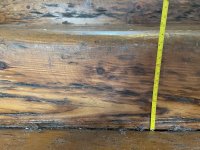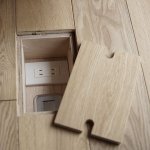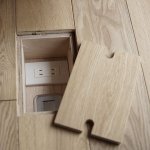- Joined
- 19 Aug 2019
- Posts
- 257
don't pretend you're not humming it
I really want some of what you are taking.
don't pretend you're not humming it
I really want some of what you are taking.
An example. Scroll the pictures and you'll see what I mean by width. Obviously you want to match the wood to your floorboards. Who knows what would yours are as 7inches sounds like you've got rows of joists as floorboards
https://www.ebay.co.uk/itm/FLOORBOA...2349624.m46890.l49286&mkrid=710-127635-2958-0

I'm sorry I don't know enough to be able to identify different wood.

Not really doable if I'm honest. The trick will be to find a good enough match for the boards, and remove the entire section you're replacing. Make the cover out of that nice match. Then use a router or Forstner drill bit to make the cavity.Does anyone know of a tool that would allow me to cut a section of the floorboard out (not going all the way through) leaving the section intact?
Bearing in mind that I don't have much access to the sides of the wood.
I'd like to be able to do this:

But, obviously, I can't cut all the way through the wood and I can't figure out a way to cut horizontally without having access to the sides (apart from maybe a cm)
Fill in the small differences with a paste of sawdust and wood glue once you have the slivers in and level.
Fill in the small differences with a paste of sawdust and wood glue once you have the slivers in and level.
Here is a video. Please advise.
Dye the slithers to match the floorboards if you're going to leave it bare. But if you're going to cover it with carpet, parquet, or whatever, just don't bother. The gaps will let the wood breath.
When hammering in the wedge slithers some bits of the length will snap and go in deaper where the gap is wider or you might need to switch to a wider wedge part way through the run.Any idea what I do about the boards that aren't parallel; i.e the gap gets smaller then gets bigger.
Just to check a couple of things. You are putting glue on these slithers before hammering them in right?
Also how are you taking off excess from the top of the slithers? Just want to check they're in really tight and that you're having to cut some proud slither off because you couldn't get anymore in.
I was going to sand them down but videos on yt suggest a chisel first so I'll do that.
You might consider hammering them to just below the level of the boards then topping them with sawdust and glue for a more even finish.
That was just a test. Yes, I plan on smearing wood glue on the sides of them.
I was going to sand them down but videos on yt suggest a chisel first so I'll do that.
I don't think you need to do this.You might consider hammering them to just below the level of the boards then topping them with sawdust and glue for a more even finish.
Yes that's
I don't think you need to do this.
Chisel then sand the whole floor to get an even finish. Have glue / filler on the surface will mean you'll have patches that stand out more after coating. The point of the slivers is to try and avoid this.

